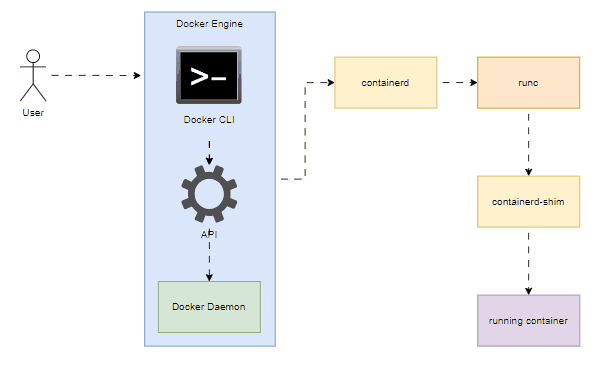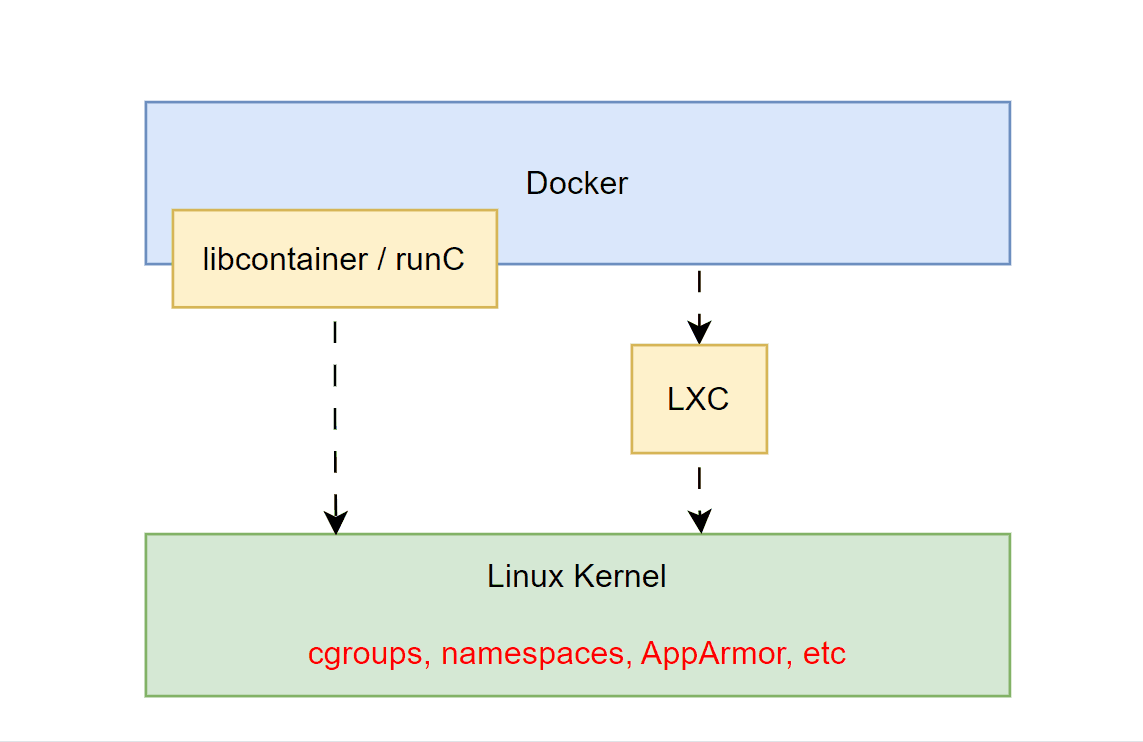Docker Architecture
Docker Engine Architecture

Docker Engine is the heart of the container and it consists of 3 core elements;
- Docker CLI
- A command line interface that the user will use to run the commands to manage Docker objects.
- REST API
- Enables the communication between applications and Docker and gives Dockerd instructions.
- Docker Daemon (dockerd) ---> Server
- It’s the server responsible for creating and managing objects.
- It’s the heart of Docker.
containerd
A set of open industry standards around container formats and runtime. OCI created two specifications to make the creation of container standards more efficient.
- Runtime-spec
- Image-spec
These two specifications mainly defines the lifecycle of a container/image technology. For example, delete command should delete a container/image, etc.
It manages the container lifecycle (start, stop, pause, delete), image distribution (push, pull to/from registries).
When the user makes a request to dockerd, containerd will push/pull the image to/from registries, and convert the image that was downloaded into an OCI compliance bundle.
libcontainer/runC

At the very beginning, Docker has a monolithic architecture and used LXC (Linix Container) technology to build environments for applications. After a while, the architecture of Docker was modified to a modular design, allowing for quicker innovation. Also, they replaced LXC with libcontainer as the default execution environment, now known as runC.
cgroups - Resource allocation for a given process can be easily monitored and managed via Linux OS, and resource limits can be set for memory, CPU, and network resources.
namespaces - Isolating processes from one another. In each container, processes will run in their own namespace and won’t be able to access anything outside of its namespaces. (Docker containers have network isolation (via libnetwork), allowing separate virtual interfaces and IP addresses for each container, that means that the container will have its own virtual interfaces, routing and ARP tables).
Docker use namespaces to isolate
- Process Id (pid) - Two proccesses cannot have the same process Id, with the help of namespaces, each process can have multiple process IDs associated with it.
- Unix Timesharing Systems (UTS)
- Mount (mnt)
- Inter-Process Communication (IPC)
- Network (net)
runC is a lightweight CLI and it’s used to create and run containers. The user can use the CLI to spawn and run the containers without Docker, so it can be easily integrated with higher-level container orchestration systems like Kubernetes.
- It will interact with the cgroups and namespaces on the kernel levels to create and run a container.
- In each execution,
/tmp/docker/[uuid]/is created as the container’s root file system.
containerd-shim
containerd-shim is mainly use to make the containers daemon less, monitors the state of the container, and it is in charge of handling input (STDIN) and output (STDOUT) and notifying the Docker Daemon about the exit status.
It mainly takes care of the containers when the daemon is down or restarted. That means, the containers will run in the background and will be attached back to the daemon when it comes back or online.
How containerd-shim make the container become daemonless container?
- Each time a container is created, containerd forks an instance of runC
- After runC creates the container, the runC process will exit, and shim will replace runC and become the new container parent.
Docker Objects
Docker Objects consists of 4 core elements;
- Images
- Containers
- Volumes
- Networks
Images
A Dockerfile is a text file that will create a custom Docker image from a set of commands or instructions. Each instruction in the Dockerfile will represent a layer of the Docker image.
Docker image acts as a set of instructions to build a Docker container, you can say it is a read-only template.
The Docker image contains all the necessary components for the application to run as a container, including the source code, tools, libraries, dependencies, and more. The user can build an image from a Dockerfile through docker build command.
Containers
Docker Container is an instance of an image running as a process. It is a standalone or executable package of software that has everything like application source code, tools, libraries, dependencies, runtime, settings, etc that you need to run an application.
Volumes
Docker volume is used to persist and share the container’s data across containers. Folders on your host machine’s hard drive are mounted into containers as volumes, which allows the container to write its data into the host volumes.
Benefits: Volumes are easy to backup.
Networks
Docker networking enables a container to be able to communicate with other containers. It can link a Docker container to as many networks as the user requires. It’s used to create an isolated environment (provide an isolation) for Docker containers.
Example of Docker network drivers;
- Bridge
- Host
- None
- Overlay
- Macvlan
Registry
Docker Enterprise Edition provides a private trusted registy known as Docker Trusted Registry (DTR).
Docker images are stored in a registry via docker push command, which enables the sharing and publishing of images either publicly or within a private organization.
Example;